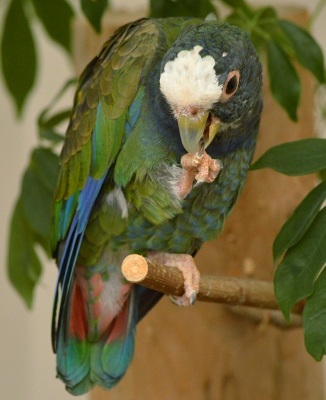
It’s July 31st and while it may be Harry Potter’s birthday, today also marks the end of our Animal of the Month for July. We hope you were following us on Twitter @ExoticPetVets as we tweeted all month long about the underrated white-capped Pionus. But if you missed any of our tweets, here is a summary. Did you know?:
- There are eight species of Pionus parrots, but only five are usually kept in captivity. The white-capped Pionus (Pionus senilis) is one of them.
- So how do you pronounce Pionus anyway? Pionus is pronounced py-OH’-nihs.
- White-capped Pionus parrots are the smallest of the Pionus species and are endemic to Mexico and Central America.
- Wild white-capped Pionus parrots live in tropical forests, but they can also be found living in pine and oak forests at an altitude of 1,600 metres (6,000 feet) above sea level. They build their nests in tree cavities.
- White-capped Pionus parrots are social birds and in the wild will feed in flocks of up to 50 birds.
- The white-capped Pionus is a stockily built medium-sized parrot with a short tail. When fully grown, they are about nine inches (23 cms) in length on average.
- As their name suggests, white-capped Pionus parrots have a white forehead. They also have a patch of white feathers on their throats.
- The body of the white-capped Pionus is mostly green mixed with patches of blue, red, brown and turquoise.
- White-capped Pionus parrots are considered to be sexually monomorphic, meaning the physical differences between females and males is not obvious.
- White-capped Pionus parrots are considered to be generally quiet and more laid back compared to some other parrot species.
- Because of their softer voices, white-capped Pionus parrots are considered to be good pets for families who live in apartments or condos.
- But as with all parrot species, the white-capped Pionus will learn to match the noise-level of a home. The louder the home, the louder the bird.
- Like other Pionus parrots, the white-capped Pionus is not famous for having a sophisticated ability to mimic human speech or other sounds.
- White-capped Pionus parrots can mimic human speech and develop a vocabulary, but their voices tend to be quieter and more raspy than other parrot species.
- White-capped Pionus parrots have a unique defense behaviour when they are frightened – they will make a wheezing noise.
- When they feel threatened, white-capped Pionus parrots will make short hissing noises that sound like they are having trouble breathing – as if having an asthma attack – in order to startle those who are frightening them.
- In captivity, white-capped Pionus parrots can be prone to obesity and vitamin A deficiencies and should be fed a nutritious diet of pellets plus fruits and veggies under the guidance of an avian veterinarian.
- When properly cared for, the white-capped Pionus parrot can live anywhere between 25 and 40 years.

